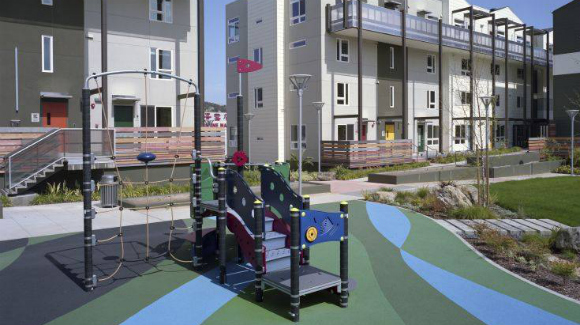
(Photo Credit: Brian Rose/David Baker Architects)
This post originally appeared on PayForSuccess.org and the Ideas Blog from Investing in What Works for America’s Communities.
The Challenge: Concentrated Poverty is Bad for Health
Neighborhoods play a central role in brokering Americans’ access to opportunity, and their exposure to environmental risks. It follows that disinvested and high-poverty areas are associated with poor health outcomes—thanks largely to place-based “social determinants” such as limited access to essentials like fresh food and recreation, and exposure to violence and other sources of stress and trauma.
Growing up in areas just a few miles apart can mean a dramatic difference in life expectancy. In New Orleans, for example, this figure can vary by up to 25 years for different neighborhoods. Low-income and minority families most likely to reside in segregated and high-poverty areas—nearly half of poor Black children live in neighborhoods with poverty rates above 30 percent —also have elevated rates of chronic but preventable medical conditions, and these trends are likely to continue.
Take diabetes, for example: the national prevalence for adults is currently about 12 percent, but a recent study projected that the lifetime risk of being diagnosed among those born between 2000 and 2011 is over 50 percent for Hispanic men and women, as well as for non-Hispanic black women. These conditions are also very expensive to treat—for African Americans with diabetes, per-person annual medical expenditures attributable to the condition approach $10,000 —and public insurance programs, such as Medicaid, cover a substantial portion of these costs.
Housing Mobility as an Investment in Population Health
Health disparities in the United States clearly demand policy responses that leverage and account for the power of places in determining health. A promising, though rarely utilized strategy is assisted housing mobility, which enables very low-income families with tenant-based housing vouchers to relocate from high-poverty neighborhoods to healthier and better-resourced environments.
The evidence around this strategy’s ability to generate returns in health and other areas is strong. The U.S. Department of Housing and Urban Development’s Moving to Opportunity randomized control experiment, for example, demonstrated that moving for even a short period of time from a high-poverty neighborhood to a lower-poverty one can deliver significant health improvements in areas such as adult diabetes and extreme obesity, as well as major depression. Other studies have shown that mobility programs have the potential to positively impact a range of child health areas, reduce exposure to trauma and chronic stress (which can be especially harmful early in life), and otherwise improve disadvantaged children’s life trajectories by helping them gain sustained access to better-resourced schools and educational environments.
Mobility program supports such as counseling and housing search assistance also enable low-income families to make health-promoting housing choices that they already want to pursue, but are unable to without help. Moving out isn’t the right decision for every family living in a poor neighborhood—and mobility programs should be paired with targeted community investments as part of broader platforms to increase opportunity for those living in concentrated poverty—but practitioners and researchers have learned that many are eager for a change in environment.
Why Pay for Success Financing Makes Sense for Housing Mobility
Even as housing mobility is gaining popularity among policy experts as a promising tool to promote population health, there are several barriers to funding these programs. First, mobility is a classic example of misaligned incentives via the “wrong pocket problem,” where an investment in one sector (housing) generates cost savings for another (health care). In addition, public housing authorities that administer rental assistance programs—upon which mobility services are typically layered—are highly regulated and face continual funding cuts. As such, they do not have the resources to support mobility programs. Mobility is also an “upstream” intervention that does not generate immediate, short-term health improvements traditionally favored by health care payers—even if holistic, longer-term strategies are critical to improving population health.
However, incentives in the health care delivery system are beginning to align around supporting such upstream investments in the social determinants of health. The current challenge, then, is to demonstrate to health agencies and other stakeholders that mobility is a worthy investment. Pay for success financing is a promising vehicle that could serve the dual purpose of supporting new or expanded mobility programs in the short term, while building the case for future support by validating and expanding upon the existing evidence base—in essence, serving as catalytic capital to trigger additional investment from public agencies and investors focused on health and social equity.
Under a pay for success arrangement for housing mobility, private investors would support the up-front costs of providing mobility services to low-income families in a given housing authority’s voucher program, and a health care agency (and possibly other payers) would agree to repay investors, plus a reasonable return, only if certain health outcomes—such as reductions in diabetes prevalence—are achieved over an agreed-upon time period.
Pay for success could address each of the challenges to implementation that we named above, and offer additional benefits—establishing working relationships among sectors that rarely collaborate, building the case for further investment of health dollars into upstream and place-conscious community development interventions, and addressing a pressing social challenge at a regional scale, which is critical to any health-and-opportunity agenda but typically very hard to do.
Next Steps
Housing mobility stakeholders need to understand the opportunities and potential challenges around using pay for success financing to support assisted housing mobility. We are excited to advance this discussion by publishing a concept paper on this topic this fall with the Federal Reserve Bank of San Francisco. Please be on the lookout for a publication announcement, and in the meantime we welcome your inquiries.
Dan Rinzler is Special Projects Coordinator at the Low Income Investment Fund
Mary Cunningham is a Senior Research Associate at the Urban Institute
Phil Tegeler is Executive Director at the Poverty & Race Research Action Council

